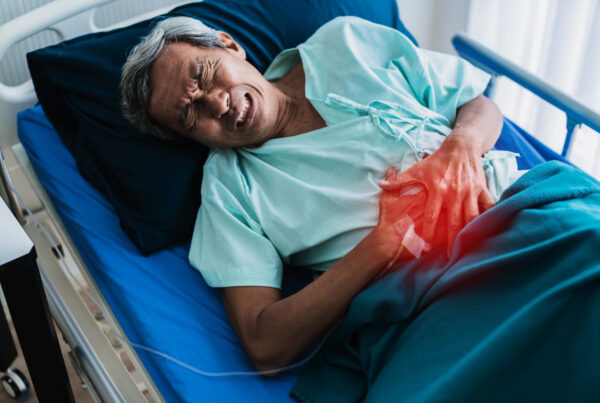A heart attack also named a myocardial infarction, occurs when a part of the heart muscle doesn’t get enough blood.
Coronary artery disease(CAD)is the main reason for heart attacks. Another less common but dangerous cause is a severe spasm or sudden contraction of the coronary artery that can block blood flow to the heart muscle. Read the blog article to know its symptoms.
Typical heart attack symptoms
-
Chest Pain
You may feel this discomfort or pain in your chest. It can feel like squeezing in the chest lasting more than a few minutes. This pain may come and go.
-
Upper Body Pain
Your chest pain spreads beyond the chest to the shoulders, arms, back, neck, teeth, or jaw. Some people even suffer upper body pain with no chest discomfort.
-
Stomach Pain
Pain may proceed downward into the belly area and may feel discomfort like heartburn.
-
Heart palpitations
You may feel heart palpitations.
-
Shortness of breath
You may feel suffocated and gasp for breath. This is a crucial sign before any chest discomfort. Though some people don’t face it.
-
Anxiety
Without any apparent reason, you may feel a sense of doom. You may feel like suffering from a panic attack.
-
Lightheadedness
Lightheadedness is also a sign of a heart attack. Apart from chest pressure, you might feel faint or might pass out.
-
Sweating
You feel suddenly sweaty with cold, frigid skin
-
Nausea and vomiting
You may feel like vomiting and sick to your stomach.
Call 9-1-1 if you notice symptoms of a heart attack.
If you face any of these symptoms of a heart attack in yourself or someone else, call 9-1-1 before too late. Every minute is crucial. The sooner you get to an emergency room, the sooner you can get therapy to decrease the amount of damage to the heart muscle. At the hospital, healthcare professionals can run tests to check if a heart attack is occurring and follow the best treatment.
In some cases, a heart attack needs cardiopulmonary resuscitation(CPR)or an electrical shock(defibrillation)to the heart to start the heart pumping again. Until any doctor arrives, bystanders are trained to use CPR or a defibrillator.
Please understand that as soon as you can able to start the treatment, surviving a heart attack increases. I
Risk factors of a heart attack
Your fast lifestyle, several health conditions, your family history, age everything is linked to your heart health. These are the risk factors you should be aware of. Researchers found that half of all Americans have at least one of the three key factors for heart disease.
- Smoking
- High blood pressure
- High blood cholesterol
Yes, we know some risk factors cannot be unchanged like your age and family history. But you can take steps to decrease your risk by changing the factors you can control.
What can I do to recover after a heart attack?
If you have had a heart attack, that means your heart is damaged somehow. This could impact your heart’s rhythm and its capacity to pump blood to the rest of the body. So, you have to be very sincere as another attack or conditions such as stroke, kidney disorders, and peripheral arterial disease can risk your life.
You can lower your chances of having future health problems following a heart attack with these steps:
-
Start to engage yourself with physical activity
I would highly recommend you talk with health professionals about the things you do each day in your life and work. Your doctor may suggest you decrease your work pressure, travel, or sexual activity for some time after a heart attack.
-
Lifestyle changes
No matter what you do, lifestyle change is everything. You have to follow a healthy diet, increase physical activity, and quit smoking. In addition to this, you have to learn how to manage stress and take your prescribed medicines regularly. Before starting something, it is good to ask your doctor about attending a program called cardiac rehabilitation to guide you make these lifestyle changes.
-
Cardiac rehabilitation
It is an essential program for any heart attack, heart failure, or other heart problem survivor. This program is listed to them because they required surgery or medical care. This program includes
- Physical activity
- Learning about healthy living including taking medicine religiously, healthy eating, and guide to stop smoking
- Guidance to take care of mental health and find ways to reduce stress
Angina vs heart attack
If you are ever confused between angina and heart attack where is some guidance about it? Generally, chest pain caused by decreased blood flow to the heart muscle is called angina. Angina is a common symptom of upcoming heart disease. There are two types of angina:
-
Stable angina
It is the most common type of angina. The cause of these types of angina is physical exertion or stress.
-
Unstable angina
It is quite unpredictable. You should take it seriously as soon as you reach a medical emergency.
An angina attack can feel like a heart attack, and in many cases — especially with unstable angina — it can be hard to tell angina from an actual heart attack.
How to differentiate between stable and unstable angina?
If you suffer stable angina that’s brought on by exertion and eases with rest. you will suddenly sense chest pain but not for so long then it is a stable enigma. If chest pain doesn’t stop with rest or comes and goes for 10 minutes or more, you may be having a heart attack.
I will highly recommend you consult with a doctor about how to handle your enigma. They know you well and guide you properly about this life-threatening disease and warn you if your chest pain is a symptom of a heart attack.
Treatment
Common procedures include
Stent, angioplasty, heart bypass surgery. pacemaker, a heart transplant.
Numerous tests can recognize whether you’ve had a heart attack. If the diagnosis shows you’ve had a heart attack, there are proper treatments that can help restore blood flow to your heart and minimize complications. If you have any risk factors for a heart attack, talk with your health professionals about ways you can choose to lower your risk of a heart attack.
source: https://www.cdc.gov/heartdisease/heart_attack.htm










